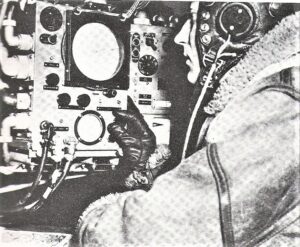In a reference to the often complicated tactics involved, cycle racing has been described as ‘chess on wheels’. So it was perhaps appropriate that Dr Phil Judkins’ presentation on technological developments in air warfare during WWII should include an illustration of a rather Heath Robinson adaptation of an upturned bicycle used to rotate a radar aerial through the required 360 degrees.
We welcomed back Dr Judkins, who had spoken to us only seven weeks earlier and who kindly agreed to stand in at short notice when our scheduled speaker became ill. Phil’s latest talk, Chess – Europe’s ‘Wizard War’ in the Air, to give it its full title, was a follow-up to his equally fascinating presentation on the Atlantic shipping convoys.
Phil is an internationally acknowledged expert on the history of radar, radio interception and electronic warfare. Retiring from a successful business career, he gained a PhD in the history of radar from Cranfield University, taught the MA in the History of Military Intelligence at the University of Buckingham and currently researches interwar electronics as a Visiting Fellow at the University of Leeds. He chairs the Defence Electronics History Society.

Phil gave us a hint of what was to come when he told us: “I’d like to recount the story about the air war which you don’t usually hear – the moves in the deadly chess game between German and British scientists, and between British and German air commanders, fought out for six years in the night skies over Europe, where all the chess moves decided who would live and who would die.”
It was chilling stuff. As Phil added, neither side had all the good ideas and neither side made all the mistakes. But Britain, he pointed out, had a strange definition of the word ‘secret.’ Tight secrecy surrounded radar development, and manufacturers were rigorously checked for foreign connections – or so we were told.
Prior to 1939 the annually published RAF List contained the address and all staff details of our secret radar research station at Bawdsey, in Suffolk, and this was publicly available from HM Stationery Office. For good measure, a free copy was delivered each year to the German Embassy in London.
We built huge radar aerials, 360 feet high, which featured on holiday postcards. In Arthur Ransome’s “We didn’t mean to go to sea”, the children sailed back from Holland by looking for the tall radio towers at Bawdsey! And there was no restriction on where our manufacturers bought their parts, so we bought from Italy, Austria and – yes – Germany.
Britain saw radar as essentially defensive. We guessed early in the war that the Germans might try to jam our radar, and our future head of Fighter Command, Air Marshal ‘Stuffy’ Dowding, had written orders as early as 1934, when he was in charge of research and development, that our scientists must find a way of stopping enemy jamming.
In August 1939 the Germans loaded a Graf Zeppelin airship with sensitive radio receivers and flew it up and down the British North Sea coast, pausing near all the big towers of our radar stations. They heard nothing identifiable as radar because they were searching for a system like their own VHF, sending out powerful radio pulses every second. But all they found was a constant, low crackly hum.
The Germans looked at their map of the British national grid, and guessed that the hum came from badly-designed insulators on the grid pylons. But by autumn 1940, as the nights drew in, the Blitz began and here the Germans were better prepared with not one but three accurate radio bombing beams to aid their navigation. This was a significantly better capability than the RAF would possess for another three years.
In a game of chess, the final outcome depends on a sequence of moves that limit your opponent’s options and may result in tangible gain. In the battle of the boffins in World War II, it was thankfully the British who eventually emerged as Grandmasters.
